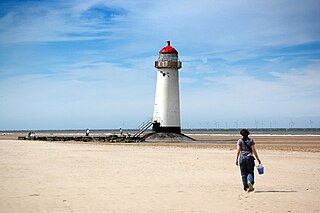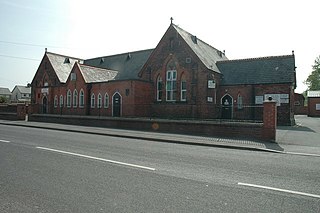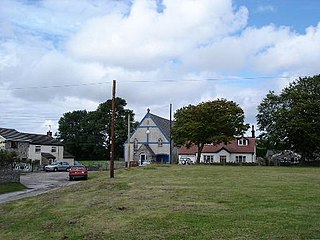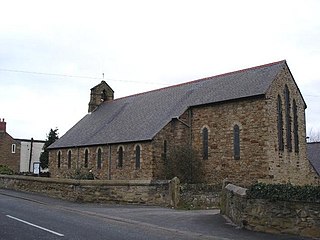
Prestatyn is a seaside town and community in Denbighshire, Wales. Historically a part of Flintshire, it is located on the Irish Sea coast, to the east of Rhyl. At the 2001 Census, Prestatyn had a population of 18,496, that increased to 18,849 at the 2011 census.

Point of Ayr is the northernmost point of mainland Wales. It is situated immediately to the north of Talacre in Flintshire, at the mouth of the Dee estuary. It is to the southwest of the Liverpool Bay area of the Irish Sea. It is the site of a RSPB nature reserve RSPB Dee Estuary Point of Ayr, and is part of Gronant and Talacre Dunes Site of Special Scientific Interest.

City of Cessnock is a local government area in the Hunter region of New South Wales, Australia. The area under administration is located to the west of Newcastle. The largest population centre and council seat is the city of Cessnock.

Ewloe is a village in Flintshire, Wales, contiguous with Hawarden and Buckley and near to Queensferry and Shotton. Situated close to the Flintshire/Cheshire sector of the Wales-England border, Ewloe forms part of Deeside. The A55 expressway passes through the town and its most notable landmark is Ewloe Castle. At the 2001 Census, the population was 4,862. Ewloe ceased being a town in its own name with all of the population being listed under Hawarden. The electoral ward remained with a total population taken at the 2011 Census of 5,420.

Delyn is a constituency represented in the House of Commons of the UK Parliament since 2019 by Rob Roberts, who was elected as a Conservative, but currently sits as an Independent following sexual harassment allegations.

Talacre is a village in Flintshire on the north coast of Wales in the community of Llanasa and the electoral ward of Ffynnongroyw, and is the northernmost settlement in Wales. The village itself has a population of 347 as of the 2011 census. It is a very anglicised village with only 98 residents born in Wales as of the 2011 census.

Caerwys is a town in Flintshire, Wales. It is just under two miles from the A55 North Wales Expressway and one mile from the A541 Mold-Denbigh road. At the 2001 Census, the population of Caerwys community was 1,315, with a total ward population of 2,496. Following reorganisation the community population fell at the 2011 Census to 1,283 with the ward raising to 2,569. The community includes Afonwen.

Penyffordd is a village, community and electoral ward in Flintshire, Wales, situated to the south east of Buckley and to the west of Chester. The name is derived from the Welsh Pen Y Ffordd – roughly translated as "the highest or furthest point of the road". The resident population of Penyffordd, as measured in the 2001 Census, was 3,715, increasing to 3,874 at the 2011 census.

Hope is a small village and community in Flintshire, north-east Wales. The village is located approximately 3 miles / 4.5 km from the Wales-England border, on the course of the River Alyn, and less than 5 miles from Wrexham.

Leeswood is a small village, community and electoral ward in Flintshire, Wales, about four miles from the historic market town of Mold. At the 2001 Census, the population was 2,143, reducing slightly to 2,135 at the 2011 Census.

Halkyn is a village and community in Flintshire, north-east Wales and situated between Pentre Halkyn, Northop and Rhosesmor. At the 2001 Census the population of the community was 2,876, increasing slightly to 2,879 at the 2011 Census. Pentre Halkyn is in the community.

Brynford is a village and community in Flintshire, Wales. It is located to the south west of the town of Holywell and near the A55 road. Brynford had a population of 1,059 at the 2011 census.

Dyserth is a village, community and electoral ward in Denbighshire, Wales. Its population at the 2011 United Kingdom census was 2,269 and remained an estimated 2,271 in 2019. It lies within the historic county boundaries of Flintshire. Its main features are extensive quarrying remains, waterfalls and the mountain Moel Hiraddug. Its railway line, formerly part of the London and North Western Railway, finally closed in 1973 and is now a footpath.

Llanasa is a village and community in the county of Flintshire, north-east Wales. Llanasa is described as one of the ancient parishes of Flintshire. It originally comprised the townships of Gronant, Gwespyr, Kelston, Golden Grove, Picton, Trewaelod, Axtyn and Trelogan. The modern community laso includes Ffynnongroyw and Glan yr afon.
The North Wales Conference is a summer rugby league competition for teams in North Wales and Mid Wales.

Ffynnongroyw is a village in Flintshire, north Wales. It is situated on the A548 road, near the Dee Estuary coast, near Prestatyn. The name Ffynnongroyw is from the Welsh word "Ffynnon" meaning well and "groyw" meaning clear or pure. The original well is still in existence and is situated on Well Lane in the village. The population of this area is now shown under the community of Llanasa and only the electoral ward remains. The total population of this ward taken at the 2011 census was 1,808. The electoral ward includes Talacre and Picton. Taking away the population of Talacre, the population of the Ffynnongroyw is roughly 1461.

Gwespyr is a village in Flintshire on the north coast of Wales in the community of Llanasa. Gwespyr had a population of 289 people in the 2001 census. It overlooks Point of Ayr on the west side of the River Dee estuary and its sandy beaches with dunes. The hills of the Clwydian Range behind the village form the eastern boundary of the Vale of Clwyd. Gwespyr also looks respectively Welsh but is an alien name. It represents Old English for 'West-bury' which came to be interpreted as the 'west fort' meaning the westernmost fort in Mercia. Originally, it is thought to have been a strategic Mercian lookout which was reduced in importance with the development of a fortified Rhuddlan.
Elis Gruffydd (1490–1552), sometimes known as "The soldier of Calais", was a Welsh chronicler, transcriber, and translator. He is known foremost for his massive chronicle Cronicl o Wech Oesoedd, which covers the history of the world from the beginning of Adam and Eve up to the year 1552 and contains the earliest text of the Tale of Taliesin. He is also well known for his eyewitness account of England's 1543 war with France in his journal transcribed in Elis Gruffydd and the 1544 'Enterprise' of Paris and Boulogue. His presence on the battlefield has given insight into the development of protests against the campaign. Thomas Jones says "despite his long years of service in France and London, [Gruffydd] was deeply interested in the oral traditions and written literature of his native land. He quotes Welsh englynion and proverbs, records a few folk-tales, and transcribes Welsh texts from such MSS as he had at his disposal". Gruffydd is an excellent source in uncovering lost and obscure traditions and he serves as a harmoniser for Welsh traditions appearing in different ages by the same poet, such as Merlin and Taliesin.

Tegeingl, in English Englefield, was a cantref in north-east Wales during the mediaeval period. It was incorporated into Flintshire following Edward I of England's conquest of northern Wales in the 13th century.

















